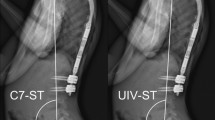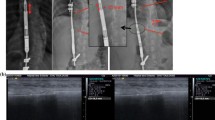Abstract
Purpose
The purpose of this study was to investigate patients with early-onset scoliosis (EOS) who completed their electromagnetic lengthening rod program to assess the demographics of this population and to analyze the evolution of clinical and radiological parameters and the occurrence of complications.
Methods
This was a multicenter study with 10 French centers. We collected all patients with EOS who had undergone electromagnetic lengthening between 2011 and 2022. They had to have reached the end of the procedure (graduate).
Results
A total of 90 graduate patients were included. The mean follow-up time over the entire period was 66 months (25.3–109). Of these, only 66 patients (73.3%) underwent definitive spinal arthrodesis at the end of the lengthening phase, whereas 24 patients (26.7%) kept their hardware in situ with a mean follow-up time from the last lengthening of 25 months (3–68). Patients had an average of 2.6 surgeries (1–5) over the entire follow-up. Patients had an average of 7.9 lengthenings for a mean total lengthening of 26.9 mm (4–75).
Analysis of the radiological parameters showed a percentage reduction in the main curve of 12 to 40%, depending on the etiology, with an average reduction of 73–44°, and an average thoracic height of 210 mm (171–214) for an average improvement of 31 mm (23–43). There was no significant difference in the sagittal parameters.
During the lengthening phase, there were a total of 56 complications in 43 patients (43.9%; n = 56/98), of which 39 in 28 patients (28.6%) resulted in unplanned surgery. In the graduate patients, there were a total of 26 complications in 20 patients (22.2%), all of which resulted in unscheduled surgery.
Conclusion
MCGR, allow to decrease the number of surgeries, to progressively improve the scoliotic deformity and to reach a satisfactory thoracic height at the price of an important complication rate linked in particular to the complexity of the management of patients with an EOS.
Level of Evidence II







Similar content being viewed by others
References
El-Hawary R, Akbarnia BA (2015) Early onset scoliosis-time for consensus. Spine Deform 3:105–106. https://doi.org/10.1016/j.jspd.2015.01.003
Canavese F, Samba A, Dimeglio A, Mansour M, Rousset M (2015) Serial elongation-derotation-flexion casting for children with early-onset scoliosis. World J Orthop 6:935–943. https://doi.org/10.5312/wjo.v6.i11.935
Mahajan R, Kishan S, Mallepally AR, Shafer C, Marathe N, Chhabra HS (2020) Evolution of casting techniques in early-onset and congenital scoliosis. J Clin Orthop Trauma 11:810–815. https://doi.org/10.1016/j.jcot.2020.06.034
Akbarnia BA, Pawelek JB, Cheung KMC, Demirkiran G, Elsebaie H, Emans JB et al (2014) Traditional growing rods versus magnetically controlled growing rods for the surgical treatment of early-onset scoliosis: a case-matched 2-year study. Spine Deform 2:493–497. https://doi.org/10.1016/j.jspd.2014.09.050
Phillips JH, Knapp DR, Herrera-Soto J (2013) Mortality and morbidity in early-onset scoliosis surgery. Spine (Phila Pa 1976) 38:324–327. https://doi.org/10.1097/BRS.0b013e31826c6743
Bowen RE, Scaduto AA, Banuelos S (2008) Does early thoracic fusion exacerbate preexisting restrictive lung disease in congenital scoliosis patients? J Pediatr Orthop 28:506–511. https://doi.org/10.1097/BPO.0b013e31817b931c
Karol LA, Johnston C, Mladenov K, Schochet P, Walters P, Browne RH (2008) Pulmonary function following early thoracic fusion in non-neuromuscular scoliosis. J Bone Joint Surg Am 90:1272–1281. https://doi.org/10.2106/JBJS.G.00184
Karol LA (2011) Early definitive spinal fusion in young children: what we have learned. Clin Orthop Relat Res 469:1323–1329. https://doi.org/10.1007/s11999-010-1622-z
Canavese F, Dimeglio A, Volpatti D, Stebel M, Daures J-P, Canavese B et al (2007) Dorsal arthrodesis of thoracic spine and effects on thorax growth in prepubertal New Zealand white rabbits. Spine (Phila Pa 1976) 32:E443-450. https://doi.org/10.1097/BRS.0b013e3180bc2340
Dimeglio A, Canavese F (2012) The growing spine: how spinal deformities influence normal spine and thoracic cage growth. Eur Spine J 21:64–70. https://doi.org/10.1007/s00586-011-1983-3
Lebon J, Batailler C, Wargny M, Choufani E, Violas P, Fron D et al (2017) Magnetically controlled growing rod in early onset scoliosis: a 30-case multicenter study. Eur Spine J 26:1567–1576. https://doi.org/10.1007/s00586-016-4929-y
Bauer JM, Yorgova P, Neiss G, Rogers K, Sturm PF, Sponseller PD et al (2019) Early onset scoliosis: is there an improvement in quality of life with conversion from traditional growing rods to magnetically controlled growing rods? J Pediatr Orthop 39:e284–e288. https://doi.org/10.1097/BPO.0000000000001299
Matsumoto H, Skaggs DL, Akbarnia BA, Pawelek JB, Hilaire TS, Levine S et al (2021) Comparing health-related quality of life and burden of care between early-onset scoliosis patients treated with magnetically controlled growing rods and traditional growing rods: a multicenter study. Spine Deform 9:239–245. https://doi.org/10.1007/s43390-020-00173-7
Thakar C, Kieser DC, Mardare M, Haleem S, Fairbank J, Nnadi C (2018) Systematic review of the complications associated with magnetically controlled growing rods for the treatment of early onset scoliosis. Eur Spine J 27:2062–2071. https://doi.org/10.1007/s00586-018-5590-4
Hardesty CK, Murphy RF, Pawelek JB, Glotzbecker MP, Hosseini P, Johnston CE et al (2021) An initial effort to define an early onset scoliosis “graduate”-the pediatric spine study group experience. Spine Deform 9:679–683. https://doi.org/10.1007/s43390-020-00255-6
Akbarnia BA, Cheung K, Noordeen H, Elsebaie H, Yazici M, Dannawi Z et al (2013) Next generation of growth-sparing techniques: preliminary clinical results of a magnetically controlled growing rod in 14 patients with early-onset scoliosis. Spine (Phila Pa 1976) 38:665–670. https://doi.org/10.1097/BRS.0b013e3182773560
Dannawi Z, Altaf F, Harshavardhana NS, El Sebaie H, Noordeen H (2013) Early results of a remotely-operated magnetic growth rod in early-onset scoliosis. Bone Joint J 95:75–80. https://doi.org/10.1302/0301-620X.95B1.29565
Hickey BA, Towriss C, Baxter G, Yasso S, James S, Jones A et al (2014) Early experience of MAGEC magnetic growing rods in the treatment of early onset scoliosis. Eur Spine J 23(Suppl 1):S61-65. https://doi.org/10.1007/s00586-013-3163-0
Cheung KM-C, Cheung JP-Y, Samartzis D, Mak K-C, Wong Y-W, Cheung W-Y et al (2012) Magnetically controlled growing rods for severe spinal curvature in young children: a prospective case series. Lancet 379:1967–1974. https://doi.org/10.1016/S0140-6736(12)60112-3
Wu A-M, Cheung JPY, Cheung KMC, Lin J-L, Jin H-M, Chen D et al (2019) Minimum 2-year experience with magnetically controlled growing rods for the treatment of early-onset scoliosis: a systematic review. Asian Spine J 13:682–693. https://doi.org/10.31616/asj.2018.0272
Migliorini F, Chiu WO, Scrofani R, Chiu WK, Baroncini A, Iaconetta G et al (2022) Magnetically controlled growing rods in the management of early onset scoliosis: a systematic review. J Orthop Surg Res 17:309. https://doi.org/10.1186/s13018-022-03200-7
Bouthors C, Gaume M, Glorion C, Miladi L (2019) Outcomes at skeletal maturity of 34 children with scoliosis treated with a traditional single growing rod. Spine 44:1630–1637. https://doi.org/10.1097/BRS.0000000000003148
Tang N, Zhao H, Shen J-X, Zhang J-G, Li S-G (2019) Magnetically controlled growing rod for early-onset scoliosis: systematic review and meta-analysis. World Neurosurgery 125:e593-601. https://doi.org/10.1016/j.wneu.2019.01.136
Cheung JPY, Yiu K, Kwan K, Cheung KMC (2019) Mean 6-year follow-up of magnetically controlled growing rod patients with early onset scoliosis: a glimpse of what happens to graduates. Neurosurgery 84:1112–1123. https://doi.org/10.1093/neuros/nyy270
Sawyer JR, de Mendonça RGM, Flynn TS, Samdani AF, El-Hawary R, Spurway AJ et al (2016) Complications and radiographic outcomes of posterior spinal fusion and observation in patients who have undergone distraction-based treatment for early onset scoliosis. Spine Deform 4:407–412. https://doi.org/10.1016/j.jspd.2016.08.007
Ilharreborde B, Ponchelet L, Sales de Gauzy J, Choufani E, Baudoux M, Pesenti S et al (2022) How does magnetically controlled growing rods insertion affect sagittal alignment in ambulatory early onset scoliosis patients? Eur Spine J 31:1036–1044. https://doi.org/10.1007/s00586-021-07071-0
La Rosa G, Oggiano L, Ruzzini L (2017) Magnetically controlled growing rods for the management of early-onset scoliosis: a preliminary report. J Pediatr Orthop 37:79–85. https://doi.org/10.1097/BPO.0000000000000597
Heydar AM, Şirazi S, Okay E, Kiyak G, Bezer M (2017) Short segment spinal instrumentation in early-onset scoliosis patients treated with magnetically controlled growing rods: surgical technique and mid-short-term outcomes. Spine (Phila Pa 1976) 42:1888–1894. https://doi.org/10.1097/BRS.0000000000002265
Hosseini P, Pawelek J, Mundis GM, Yaszay B, Ferguson J, Helenius I et al (2016) Magnetically controlled growing rods for early-onset scoliosis: a multicenter study of 23 cases with minimum 2 years follow-up. Spine (Phila Pa 1976) 41:1456–1462. https://doi.org/10.1097/BRS.0000000000001561
Cheung JPY, Yiu KKL, Samartzis D, Kwan K, Tan B-B, Cheung KMC (2018) Rod lengthening with the magnetically controlled growing rod: factors influencing rod slippage and reduced gains during distractions. Spine (Phila Pa 1976) 43:E399-405. https://doi.org/10.1097/BRS.0000000000002358
Sankar WN, Skaggs DL, Yazici M, Johnston CE, Shah SA, Javidan P et al (2011) Lengthening of dual growing rods and the law of diminishing returns. Spine (Phila Pa 1976) 36:806–809. https://doi.org/10.1097/BRS.0b013e318214d78f
Ahmad A, Subramanian T, Panteliadis P, Wilson-Macdonald J, Rothenfluh DA, Nnadi C (2017) Quantifying the “law of diminishing returns” in magnetically controlled growing rods. Bone Joint J 99:1658–1664. https://doi.org/10.1302/0301-620X
Cheung JPY, Bow C, Cheung KMC (2022) Law of temporary diminishing distraction gains: the phenomenon of temporary diminished distraction lengths with magnetically controlled growing rods that is reverted with rod exchange. Global Spine J 12:221–228. https://doi.org/10.1177/2192568220948475
Lebel DE, Rocos B, Helenius I, Sigal A, Struder D, Yazici M et al (2021) Magnetically controlled growing rods graduation: deformity control with high complication rate. Spine (Phila Pa 1976) 46:1105–1112. https://doi.org/10.1097/BRS.0000000000004044
Bekmez S, Afandiyev A, Dede O, Karaismailoğlu E, Demirkiran HG, Yazici M (2019) Is Magnetically controlled growing rod the game changer in early-onset scoliosis? A Prelim Rep J Pediatr Orthop 39:e195-200. https://doi.org/10.1097/BPO.0000000000001268
Tahir M, Mehta D, Sandhu C, Jones M, Gardner A, Mehta JS (2022) A comparison of the post fusion outcome of patients with early onset scoliosis treated with traditional and magnetically controlled growing rods. Bone Joint J 104:257–264. https://doi.org/10.1302/0301-620X
Peiro-Garcia A, Bourget-Murray J, Suarez-Lorenzo I, Ferri-De-Barros F, Parsons D (2021) Early complications in vertical expandable prosthetic titanium rib and magnetically controlled growing rods to manage early onset scoliosis. Int J Spine Surg 15(2):368–375. https://doi.org/10.14444/8048
Dumaine AM, Yu J, Poe-Kochert C, Thompson GH, Mistovich RJ (2022) Surgical site infections in early onset scoliosis: what are long-term outcomes in patients with traditional growing rods? Spine Deform 10:465–470. https://doi.org/10.1007/s43390-021-00412-5
Acknowledgements
We would like to thank all the surgeons who enabled us to compile this record of patients: Pr Sebastien Pesenti, Pr Thierry Haumont, Pr Franck Accabled, Dr Nectoux
Funding
The authors did not receive support from any organization for the submitted work.
Author information
Authors and Affiliations
Contributions
Nicolas Mainard Writing–original draft preparation, Writing–review and editing, Investigation. Elie Saghbini Writing–review and editing, statistical analysis. Tristan Langlais Writing–review and editing, Supervision, Validation. Raphael Vialle Writing–review and editing, Supervision, Validation. Yan Lefevre Writing–review and editing, Investigation. Pierre JourneauWriting–review and editing, Investigation. Jean Damien Metaizeau Writing–review and editing, Investigation. Elie Choufani Writing–review and editing, Investigation. Vincent Cunin Writing–review and editing, Investigation. Richard Gouron Writing–review and editing, Investigation. Brice Ilharreborde Writing–review and editing, Investigation. Damien Fron Writing–review and editing, Investigation, Supervision, Project administration, Validation, Conceptualization. Federico Canavese Writing–review and editing, Investigation, Supervision, Project administration, Validation
Corresponding author
Ethics declarations
Conflict of interest
The authors have no competing interests to declare that are relevant to the content of this article.
Additional information
Publisher's Note
Springer Nature remains neutral with regard to jurisdictional claims in published maps and institutional affiliations.
Rights and permissions
Springer Nature or its licensor (e.g. a society or other partner) holds exclusive rights to this article under a publishing agreement with the author(s) or other rightsholder(s); author self-archiving of the accepted manuscript version of this article is solely governed by the terms of such publishing agreement and applicable law.
About this article
Cite this article
Mainard, N., Saghbini, E., Langlais, T. et al. Clinical and radiographic evolution of graduate patients treated with magnetically controlled growing rods: results of a French multicentre study of 90 patients. Eur Spine J 32, 2558–2573 (2023). https://doi.org/10.1007/s00586-023-07762-w
Received:
Revised:
Accepted:
Published:
Issue Date:
DOI: https://doi.org/10.1007/s00586-023-07762-w




